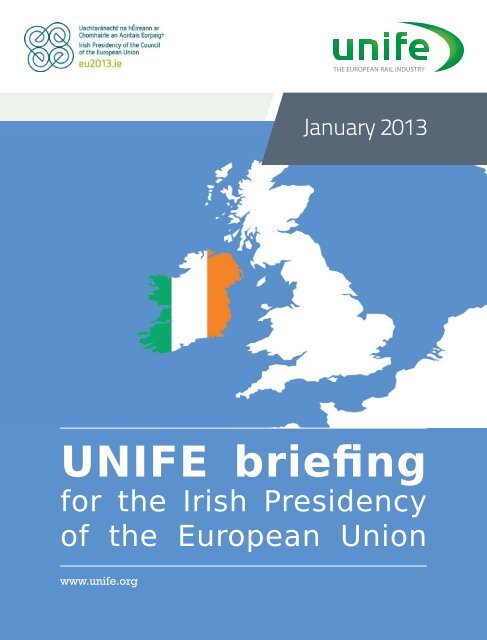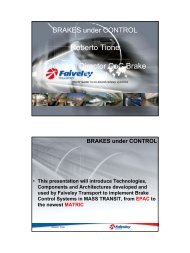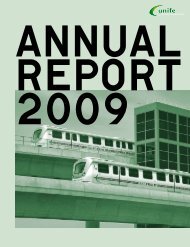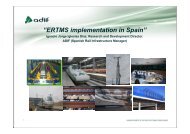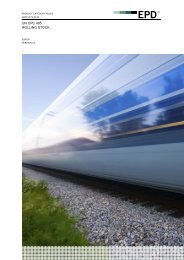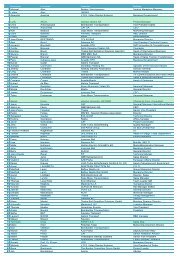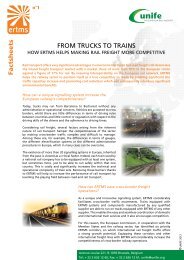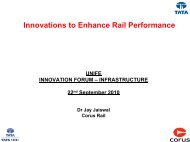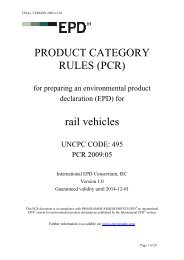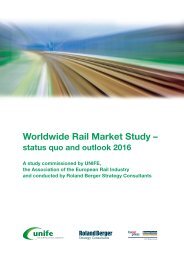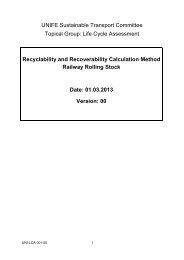Download - Unife
Download - Unife
Download - Unife
Create successful ePaper yourself
Turn your PDF publications into a flip-book with our unique Google optimized e-Paper software.
January 2013<br />
UNIFE briefing<br />
for the Irish Presidency<br />
of the European Union<br />
www.unife.org
Imprint<br />
Published by<br />
Designed by<br />
UNIFE - the European Rail Industry Oxalis<br />
Avenue Louise 221, bte 11<br />
www.oxalis.be<br />
B - 1050 Brussels<br />
www.unife.org<br />
Printed by<br />
+32 2 626 12 60<br />
Drifosett Printing sa<br />
Together with 400 European transport www.drifosett.com<br />
stakeholders and its partner association<br />
Photographs CER, Copyright the Community of European Railways and Infrastructure Managers, UNIFE<br />
www.ribblevalleyrail.co.uk<br />
will start the political year with an Annual Paper Reception held in Brussels on 26 February<br />
2013. At the presence of Vice-President FSC Certified of the Recycled European Paper Commission Siim<br />
www.geograph.ie<br />
www.myguideireland.com<br />
Kallas, Benedikt Weibel, former CEO of the Swiss Federal Railways (SBB) and Dr<br />
www.insideview.ie Johannes Nicolin, German engineer, will receive the prestigious European Railway<br />
Award.<br />
www.whatsonni.com<br />
www.flickr.com/Yellabelly*<br />
www.flickr.com/james The Irish Transport smyth Minister Mr. Varadkar is of course invited to be the keynote<br />
Ruth Gregory speaker of this high level event of the rail community<br />
N.Kirby
tABLE OF COntEntS<br />
1. Introduction - UNIFE’s value system<br />
2. Dossiers during the Irish Presidency<br />
2.1. Connecting Europe Facility<br />
2.2. TEN-T Policy Review<br />
2.3. Cohesion Policy Review<br />
2.4. Fourth Railway Package<br />
2.5. FTA negotiations with Japan<br />
2.6. International Public Procurement Instrument<br />
2.7. Horizon 2020 and the future of Transport Research<br />
3. UNIFE initiatives during the Irish Presidency<br />
3.1. SHIFT²RAIL, the rail Joint Technology Initiative<br />
3.2. ERTMS<br />
3.3. UNIFE-CER Annual Reception<br />
4. About UNIFE<br />
5. Notes<br />
5<br />
6<br />
6<br />
8<br />
9<br />
10<br />
12<br />
13<br />
14<br />
16<br />
17<br />
19<br />
20<br />
21<br />
22<br />
3
1. IntrODUCtIOn -<br />
UnIFE’S VALUE SYStEm<br />
Rail is the greenest and safest mode of transport. However,<br />
despite its obvious benefits, rail today is performing<br />
at a level lower than should be expected. It still has<br />
great potential that needs to be unleashed in order to<br />
meet two key objectives set in the Commission’s Transport<br />
White Paper published in March 2011:<br />
• 30% of road freight over 300 km should shift to other modes such as<br />
rail or waterborne transport by 2030, and more than 50% by 2050,<br />
facilitated by efficient and green freight corridors. To meet this goal<br />
will also require appropriate infrastructure to be developed.<br />
• By 2050, complete a European high-speed rail network. Triple the<br />
length of the existing high-speed rail network by 2030 and maintain<br />
a dense railway network in all Member States. By 2050 the<br />
majority of medium-distance passenger transport should go by<br />
rail.<br />
“Rail is the greenest and<br />
safest mode of transport.”<br />
This briefing contains information on the key transport policy dossiers<br />
that will be discussed during the Irish Presidency of the European<br />
Council (part 2) and it explains important initiatives to which UNIFE<br />
would like to draw the attention of the Irish Presidency (part 3).<br />
5
2. DOSSIErS DUrInG tHE<br />
IrISH prESIDEnCY<br />
Seven main dossiers that will be discussed during the Irish<br />
Presidency can play an important role for attaining the objectives<br />
outlined above.<br />
2.1. Connecting Europe Facility<br />
With a proposed budget of up to € 50 billion between 2014 and 2020, the Connecting<br />
Europe Facility (CEF) is specifically designed to promote growth, jobs and<br />
competitiveness through targeted infrastructure investment at European level.<br />
6
It will support the roll-out of high-performing, sustainable and joined-up trans-<br />
European networks in the fields of transport, energy, and broadband and digital<br />
services.<br />
On 18 December 2012, the European Parliament’s ITRE and TRAN Committees<br />
voted on the amendments to the European Commission’s proposal for the Connecting<br />
Europe Facility. Under the Danish Presidency, the EU Council reached<br />
a partial general approach in June, which is quite in line with UNIFE’s position.<br />
The dossier is expected to be formally approved in 2013 under the Irish Presidency<br />
of the EU Council.<br />
Following the EP vote of 18 December 2012, UNFE regrets the reduction of the<br />
EU financing rate for on-board equipment to 40% of the eligible cost for ERTMS.<br />
As the full benefits of ERTMS are realised only when a significant number of<br />
neighbouring countries have made the necessary investments to upgrade their<br />
network, EU funding is pivotal in increasing the pace of ERTMS deployment<br />
along the European railway network.<br />
UNIFE calls upon the Council of the European Union to<br />
adopt the following measures on the Connecting Europe<br />
Facility:<br />
01<br />
Be consistent with the objectives of the Transport White Paper<br />
by giving clear priority to the development of rail transport<br />
infrastructure;<br />
02<br />
Strengthen the importance of ERTMS deployment as a horizontal<br />
priority, by maintaining the existing financing rate of<br />
50%;<br />
03<br />
Safeguard the € 31.7 billion budget for transport infrastructure<br />
proposed by the European Commission for the EU budget<br />
2014-2020 which already covers only a marginal part of the<br />
TEN-T investment needs (€ 550 billion by 2020);<br />
04<br />
Clarify co-financing rules for transport infrastructure projects<br />
and add climate-proofing considerations to the criteria for<br />
setting co-financing rates.<br />
7
2.2. TEN-T Policy Review<br />
On 19 October 2011, the European Commission unveiled its proposals for the<br />
Trans-European Transport Network (TEN-T) Guidelines. The Commission proposed<br />
a dual layer approach consisting of a core network and a comprehensive<br />
network. The overall objective is to finalise the core network by 2030 and the<br />
comprehensive network by 2050. UNIFE welcomes the Commission’s proposals<br />
which are mostly in line with the objectives set in the Transport White Paper<br />
published in March 2011.<br />
In particular, UNIFE appreciates the Commission’s intention to focus on the<br />
implementation of TEN-T projects, subjecting EU Member States and all other<br />
actors involved to the rights and obligations of the Regulation. Under current<br />
regulation, one Member State can effectively block the implementation of an entire<br />
project.<br />
On 18 December 2012, the European Parliament’s TRAN Committee voted on the<br />
amendments to the European Commission’s proposal for the Trans-European<br />
Transport Network Guidelines.<br />
The European Parliament made a number of significant improvements to the<br />
Commission’s proposal, focussing on the actual implementation of the programme.<br />
The dossier is expected to be formally approved in 2013 under the Irish Presidency<br />
of the EU Council.<br />
UNIFE calls upon the Council of the European Union to<br />
adopt the following measures in the framework of the<br />
TEN-T Policy Review:<br />
01<br />
02<br />
A clear priority to develop rail transport infrastructure that reflects<br />
the modal shift objectives set out in the Transport White<br />
Paper;<br />
The setting up of intermediate objectives in order to reinforce<br />
the credibility of the programme. For example, 2023 would be<br />
a very suitable milestone for an intermediate reality check of<br />
the programme;<br />
8
03<br />
04<br />
An increase and a more efficient use of the TEN-T budget,<br />
complemented with new resources;<br />
Clear mandatory provisions for ERTMS full implementation by<br />
2030 on all railway lines of the core network and by 2050 on all<br />
railway lines in the comprehensive network.<br />
2.3. Cohesion Policy Review<br />
On 6 October 2011, the European Commission presented its legislative<br />
proposals for the next programming period of the Cohesion<br />
Policy (2014-2020). UNIFE very much welcomes these<br />
proposals that are mostly in line with its position to green the<br />
Cohesion Policy and improve absorption capacity of Central<br />
and Eastern European Member States.<br />
UNIFE calls upon the Council of the European Union to<br />
adopt the following measures for the next programming<br />
period (2014-2020):<br />
9
01<br />
A sufficient allocation of the Cohesion Fund and ERDF shall<br />
be given to transport (in addition to the proposed Connecting<br />
Europe Facility);<br />
02<br />
All European Regions (including the most "developed" ones)<br />
should be entitled to use ERDF to fund transport infrastructures;<br />
03<br />
Co-financing rates should be defined according to the sustainability<br />
of the projects, taking into account climate performance;<br />
04<br />
A level-playing field shall be established between transport<br />
modes as regards eligible expenditure. The deduction of revenues<br />
generated by rail infrastructure from EU co-financing<br />
should be allowed only if similar provisions exist for road<br />
transport in the Member States concerned. Alternatively, the<br />
co-financing rate of sustainable projects generating revenue<br />
should be higher than the co-financing rate of less sustainable<br />
and non-revenue generating projects;<br />
05<br />
Cohesion Policy financial instruments should allow to combine<br />
EU and private funding in pools and leasing scheme for<br />
rolling stock financing;<br />
06<br />
Ex-ante conditions as proposed by the European Commission<br />
shall be kept so as to increase funds absorption, especially in<br />
Central and Eastern European countries. This is an extremely<br />
important issue.<br />
2.4. Fourth Railway Package<br />
UNIFE considers that the 4th Railway Package offers a major opportunity to<br />
make the railway market more efficient and competitive whilst supporting the<br />
creation of a real Single European Railway Area.<br />
10
Today, markets still do not function at their optimum in rail transport, as compared<br />
to other transport modes. In a number of EU Member States, the market<br />
structure fosters effective competition. Some Member States still appear to seek<br />
to protect the incumbent operator from competition despite the fact that both<br />
the aviation sector and the road sector demonstrated the dynamics that can<br />
be set free by competition. Market opening and liberalisation must be pushed<br />
in order to allow rail transport to develop its potential and compete with other<br />
transport modes.<br />
Similarly, the creation of a Single European Railway Area is hampered by the lack<br />
of harmonisation of the different national regulatory environments and of a real<br />
European type authorisation for rolling vehicles. This situation, which results in<br />
high costs for the putting into service of railway vehicles and equipment, is in<br />
stark contrast to that of other transport modes which benefit from a simpler,<br />
harmonised authorisation regime.<br />
Currently, rolling stock with a value of € 1.6 billion is immobilised within Europe<br />
due to lengthy and cumbersome authorisation procedures (600 days on average)<br />
in different Member States.<br />
UNIFE considers the 4th Railway Package should aim to:<br />
01<br />
Enhance the role of the European Railway Agency (ERA), as<br />
outlined in the Position Paper published by CER and UNIFE on<br />
vehicle authorisation 1 ;<br />
02<br />
03<br />
04<br />
Simplify and speed up the authorisation process and harmonise<br />
it amongst Member States, with ERA becoming the single<br />
issuing authority for authorisation, ensuring the coherence of<br />
processes and rules;<br />
Enforce the process for cleaning up national rules;<br />
Empower ERA to pro-actively work with non-European bodies<br />
and ensure that European railway standards are adopted<br />
globally, and enable ERA to have an increased role on the global<br />
stage;<br />
1<br />
http://www.unife.org/uploads/CER_and_UNIFE_Position_Paper_on_the_Future_role_of_ERA.pdf<br />
11
05<br />
Ensure an efficient liberalisation of the domestic passenger<br />
markets whilst clarifying the relation between infrastructure<br />
management and railway operators, and the attribution of<br />
public service contracts under competitive conditions.<br />
2.5. FTA negotiations with Japan<br />
On 29 November 2012, the European Foreign Affairs Council (Trade) decided to<br />
give the European Commission ‘the green light’ to negotiate a Free Trade Agreement<br />
(FTA) with Japan. UNIFE welcomes the opening of the negotiations, even<br />
though immediate steps could already be taken to open the Japanese rail market.<br />
Despite the efforts made by the European Commission and the rail industry in<br />
the past four years, no significant steps have been taken so far by the Japanese<br />
government and operators to improve access to public procurement in the<br />
railway sector. This contrasts with the situation in Europe, where Japanese rail<br />
suppliers have access to the market and were indeed awarded major contracts.<br />
Whilst the launch of FTA negotiations is a significant opportunity to remedy to<br />
this situation, UNIFE considers that, as far as railway is concerned, immediate<br />
steps to open their rail market could be taken by the Japanese authorities, in<br />
line with the EU-Japan exchange of letters on railway procurement signed in<br />
December 2011.<br />
In particular, UNIFE would like to stress the following points:<br />
01<br />
The Japanese government should take immediate steps to ensure<br />
that European suppliers get a comparable and effective<br />
access to the Japanese market; these steps, which should include<br />
concrete business opportunities for European suppliers,<br />
should be carefully reviewed after one year of negotiations;<br />
02<br />
The Operational Safety Clause, if not completely removed,<br />
should be applied in a transparent, predictable, and non-discriminatory<br />
manner;<br />
The three JRs, which represent the major share of the Japa-<br />
12
03<br />
nese rail procurement market, should remain within the scope<br />
of the WTO Agreement on Government Procurement (GPA)<br />
and be covered by the FTA negotiations.<br />
2.6. International Public Procurement Instrument<br />
The European Commission published its proposals to create an international<br />
public procurement instrument in March 2012 (draft Regulation on the access<br />
of third-country goods and services to the Union’s internal market in public procurement<br />
and procedures supporting negotiations on access of Union goods<br />
and services to the public procurement markets of third countries).<br />
UNIFE member companies supply an estimated 50% of the worldwide production<br />
of railway services. As global companies whose products are usually purchased<br />
through public procurement procedures, the European rail suppliers<br />
have experienced facing different levels of openness when trying to establish<br />
themselves in non-European markets. In some countries, they face significant<br />
barriers to international public procurement in their daily operations, be it in<br />
the form of protective procurement measures, technology transfers, "buy local"<br />
provisions, or de facto exclusion. These barriers result in missed business<br />
opportunities for the European industry, and ultimately impact both economic<br />
growth and jobs. They strongly contrast with the situation in Europe, where<br />
public procurement rules are fully transparent and open as per the EU Public<br />
Procurement legislation.<br />
UNIFE therefore considers that the European trade and procurement policies<br />
should be put at the service of the industry and support the opening of third<br />
countries’ markets. The EU should aim at promoting public procurement rules<br />
which are as transparent and open as the European ones, thereby improving<br />
market access for the European industry.<br />
For this reason, UNIFE strongly supports the Commission’s proposals to create<br />
a specific procurement instrument as a means to increase the EU’s leverage<br />
in trade negotiations and create business opportunities for the European<br />
industry.<br />
13
UNIFE calls the Irish Presidency of the EU to:<br />
01<br />
Immediately launch discussions on the proposed international<br />
public procurement instrument at the EU Council;<br />
02<br />
Find a suitable compromise which could accommodate the<br />
Member States whilst featuring a high-level of ambition and<br />
creating new business opportunities for the European rail industry.<br />
2.7. Horizon 2020 and the future of Transport<br />
Research<br />
On 30 November 2011, the European Commission presented a package of measures<br />
aiming at boosting research, innovation and competitiveness in Europe<br />
through the creation of Horizon 2020, a new multiannual Framework Programme<br />
of € 80 billion for investment in research and innovation. UNIFE very<br />
much welcomes these proposals which foresee a considerable increase of the<br />
14
total multiannual Research and Innovation budget (€ 53 billion for 2007-2013)<br />
and especially appreciates the increase of the proposed budget for Transport<br />
Research (€ 7,69 billion instead of € 4,16 billion for 2007-2013).<br />
However, on 28 November 2012, the European Parliament’s ITRE Committee<br />
adopted the Madurell’s Report on “Horizon 2020 – The Framework Programme<br />
for Research and Innovation” which foresees a dramatic decrease of the future<br />
Transport Research budget: from 8.8% to 6.9% of the total Horizon 2020 budget.<br />
At a time where key European industrial companies from the rail sector with<br />
some infrastructure managers and soon with railways undertakings are teaming<br />
up to build an ambitious Research Programme aiming at building tomorrow’s<br />
railway system – the SHIFT²RAIL Joint Technology Initiative (JTI), which<br />
they intend to co-finance with the European Union – this is unfortunately a<br />
very worrying signal that is sent to the rail transport sector.<br />
UNIFE calls the Irish Presidency of the EU to:<br />
01<br />
Guarantee an ambitious budget for Horizon 2020 and more<br />
specifically for Transport Research by getting back to the initial<br />
proposal of the European Commission;<br />
02<br />
03<br />
Make sure that all research activities provide a support to the<br />
shift towards sustainable transport modes (such as rail) in<br />
line with the objectives of the White Paper on Transport;<br />
Make sure that Horizon 2020 will foresee the possibility for<br />
the EU to launch new Joint Technology Initiatives (JTI) in key<br />
economic sectors (such as the rail sector).<br />
15
3. UnIFE InItIAtIVES DUrInG<br />
tHE IrISH prESIDEnCY<br />
During the Irish Presidency, UNIFE will be working on three<br />
initiatives that have the potential to increase significantly the<br />
competitiveness of the railway sector.<br />
16
3.1. SHIFT²RAIL, the rail Joint Technology<br />
Initiative<br />
JTIs are instruments created under the current EU Research Framework Programme.<br />
They move away from the traditional case-by-case public funding of<br />
projects approach towards large scale research programs that couple research<br />
tightly to technological innovation.<br />
The European rail industry is at a turning point of its history. Whilst European<br />
companies have built up a global presence, they increasingly face competition<br />
from suppliers from other countries (e.g. China, Japan, South Korea). At the same<br />
time, the EU’s transport sector faces considerable challenges, as highlighted in<br />
the Transport White Paper. Whilst rail can make transport more sustainable, the<br />
sector clearly needs to improve its capacity to absorb bigger shares of traffic and<br />
develop its attractiveness and efficiency.<br />
It is now essential to secure adequate level of funding for research to produce<br />
real innovation in an industrial sector that accounts for € 136 billion turnover,<br />
which is rapidly growing and provides 400000 direct and indirect jobs in Europe.<br />
During the past two years, major European rail stakeholders, under the umbrella<br />
of UNIFE and in cooperation with the whole railway community – including infrastructure<br />
managers and soon leading railway undertakings – have therefore<br />
initiated a major effort to identify the priority research axes which should pave<br />
the way for tomorrow’s railways. In-depth investigations, involving hundreds<br />
of experts and engineers, have been conducted to identify how best innovation<br />
could increase the competitiveness of the European industry. These investigations<br />
have now resulted into the creation of a long term research programme<br />
on rolling stock, traffic management, infrastructure, telematics and freight, with<br />
clear strategic objectives: the SHIFT²RAIL Joint Technology Initiative (JTI).<br />
The development of the SHIFT²RAIL JTI has been supported at the highest level<br />
within the industry, with the signature of a Memorandum of Understanding<br />
(MoU) by the CEOs of the leading European rail companies in June 2012, in which<br />
they commit themselves to a long-term investment in the future of European<br />
rail research. The current signatories of this MoU are Alstom Transport, Ansaldo<br />
17
Breda , Ansaldo STS, Bombardier Transportation, CAF, Faiveley, Invensys Rail,<br />
Knorr Bremse, Network Rail, Thales, Siemens, Strukton Rail, Trafikverket, Vossloh<br />
and UNIFE.<br />
Additional companies, e.g. leading railway undertakings, infrastructure managers<br />
and industrial partners, are about to join the initiative. Altogether, these<br />
European rail stakeholders are ready to commit themselves to bring 50% of an<br />
overall budget amounting to € 1 billion over a six to seven year period in the<br />
framework of the future Horizon 2020 Programme. As a significant part of this<br />
SHIFT²RAIL budget (around 25%) will be managed through open calls for proposals,<br />
this will also encourage the participation of numerous SMEs all over Europe.<br />
UNIFE is already working with the academia and research institutes and would<br />
also be happy to discuss this issue with the Irish Presidency of the EU.<br />
The Joint Technology Initiative has been presented to Transport Commissioner<br />
Siim Kallas and Research Commissioner Máire Geoghegan-Quinn. UNIFE Members<br />
expressed their willingness to have the SHIFT 2 RAIL initiative approved by<br />
the European Commission, the Council and the Parliament in 2013 for an implementation<br />
in 2014.<br />
The final proposal has been officially presented to DG MOVE and DG RESEARCH<br />
on 13 July 2012 and is now in the hands of the European Commission for examination.<br />
An addendum to the SHIFT 2 RAIL proposal will be sent to the Commission<br />
in January 2013. UNIFE Members will present the progress on SHIFT 2 RAIL at a<br />
Rail Forum Europe dinner that will take place on 18 February 2013 at the European<br />
Parliament in Brussels. Representatives of the Irish Presidency of the EU<br />
are of course invited to participate in the dinner debate.<br />
UNIFE would be very happy to make a full presentation on the SHIFT²RAIL JTI to<br />
the Irish Presidency in Brussels or Dublin at the beginning of 2013.<br />
UNIFE calls upon the Council of the European Union to<br />
support SHIFT2RAIL, the rail sector’s Joint Technology<br />
Initiative, in this preparatory phase.<br />
18
3.2. ERTMS<br />
UNIFE suggests that ERTMS is considered as a top priority<br />
throughout the Presidency to promote a fast and coordinated<br />
migration to ERTMS throughout the EU.<br />
To date, about 62000 km of tracks worldwide<br />
are contracted to be equipped with<br />
ERTMS or are already in service². The system<br />
is a proof of European excellence, and<br />
investments outside Europe now account<br />
for more than 50% of total ERTMS sales.<br />
In Europe, ERTMS has been successfully<br />
implemented in number of countries, and<br />
where this has been the case, infrastructure<br />
managers and operators are already<br />
reaping the benefits of their investments<br />
in terms of safety, speed and capacity (e.g.<br />
Spanish and Italian High Speed networks, high-density lines in Switzerland, etc.).<br />
A new Memorandum of Understanding on ERTMS involving the European Commission,<br />
the European Railway Agency and the railway associations (CER, UIC,<br />
UNIFE, EIM, GSM-R Industry Group and ERFA) was signed on 16 April 2012 during<br />
a Danish Presidency event in Copenhagen, jointly chaired by Danish Transport<br />
Minister Henrik Dam Kristensen and Commission Vice-President Siim Kallas.<br />
UNIFE calls upon the Member States to accelerate the<br />
deployment of ERTMS in Europe as a matter of urgency,<br />
especially on the six ERTMS corridors.<br />
² Please see UNIFE ERTMS Deployment statistics on http://www.ertms-online.com/<br />
19
3.3. UNIFE-CER Annual Reception<br />
Together with 400 European transport stakeholders and its partner association<br />
CER, the Community of European Railways and Infrastructure Managers, UNIFE<br />
will start the political year with the Annual Reception held in Brussels on 26<br />
February 2013. At the presence of Vice-President of the European Commission<br />
Siim Kallas, Mr. Benedikt Weibel, former CEO of the Swiss Federal Railways (SBB)<br />
and Dr Johannes Nicolin, German engineer, will receive the prestigious European<br />
Railway Award.<br />
The Irish Transport Minister Mr. Varadkar is of course invited to be the keynote<br />
speaker of this high level event of the rail community.<br />
For further questions, please contact:<br />
Leonardo Dongiovanni<br />
Public Affairs Manager<br />
+32 2 642 23 29<br />
Leonardo.dongiovanni@UNIFE.org<br />
20
ABOUt UnIFE<br />
UNIFE represents the European Rail Industry in Brussels since 1992. The Association<br />
gathers 81 of Europe’s leading large and medium-sized rail supply companies<br />
active in the design, manufacture, maintenance and refurbishment of rail<br />
transport systems, subsystems and related equipment. A further one thousand<br />
suppliers of railway equipment partake in UNIFE activities through 15 national<br />
rail industry associations. UNIFE members have an 80% market share in Europe<br />
and supply more than 50% of the worldwide production of rail equipment and<br />
services.<br />
UNIFE represents its members’ interests at the level of both European and international<br />
institutions. On the technical side, UNIFE works on the setting of interoperability<br />
standards and coordinates EU-funded research projects that aim<br />
at the technical harmonisation of railway systems. The Association is one of the<br />
supporting bodies of the European Railway Agency.<br />
UNIFE. Promote Rail Market Growth For Sustainable Mobility<br />
www.unife.org<br />
21
22<br />
nOtES


